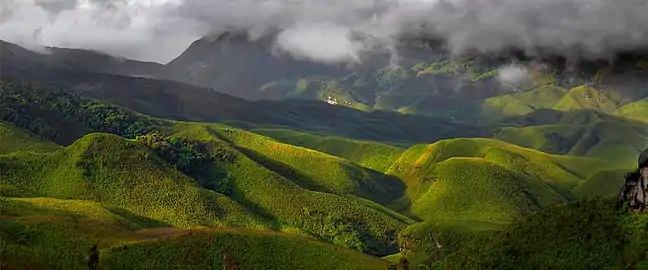Dzüko Valley
The Dzüko Valley is a valley located at the borders of the states of Nagaland and Manipur in Northeast India. This valley is well known for its natural environment, seasonal flowers and flora & fauna.[1]
| Dzüko Valley | |
|---|---|
   (clockwise from top)
Dzüko Valley guest house—a courtesy of Government of Nagaland; Dzüko Valley in Summer; a view of Dzüko Valley from the base camp | |
| Floor elevation | 2,452 metres (8,000 ft) |
| Geography | |
| Location | Viswema |
| Coordinates | 25.553479°N 94.067024°E |
| Rivers | Dzüko River |
It is situated at an altitude of 2452 m above sea level. The valley is famous for its wide range of flowers in every season but the most famous one is the Dzüko Lily and it is found only in this valley.[2]
Etymology
The word Dzüko is originally derived from the Viswema dialect of the Angamis 'Dzüko' which loosely translated means 'Soulless and Dull' referring to when some ancestors of Viswema who moved out to establish a new village in Dzüko, due to the unfavorable weather conditions they were unable to harvest crops which led them to say "the valley is very beautiful but is dull and soulless."[3]
—Oral history
A common misconception is that Dzüko derives its meaning from the Angami word which translates to Cold Water referring to the ice cold stream that flows through the valley.
Access
Trekking route
The main entry is from the foothills of Viswema where one can travel to the rest house above Teyozwü hill by a Tata Sumo taxi. From here one has to climb forty minutes to the top of the mountain (Khiyoke). This is where Dzüko starts but the main valley is still another two hours' walk away. One can exit the valley from the same route but if one is planning to come back by foot, the Jakhama route is shorter. Also it can be reached in five hours of trek from Mount Tempü of Senapati district of Manipur. The new five-hour trek route was opened by MMTA (Manipur Mountaineering and Trekking Association).
Transportation
The Asian Highway 1 and also the NH-2 passes through its foothills. The nearest airport is Dimapur Airport at Dimapur near the Assam border about 96 kilometres (60 miles) away from Viswema while the Bir Tikendrajit International Airport is located about 120 kilometres (75 miles) south of Viswema.
There is a Helipad just next to the Guest house however no service is seen in the last few years.
Ecology
The valley borders a region of old-growth forest, and is home to several rare and endangered species of flora and fauna, including the Dzüko Lily and the Blyth's tragopan, which is the state bird of Nagaland. It has periodically been threatened by forest fires, which tend to spread quickly due to prevalent wind conditions and are difficult to fight because of the inaccessible terrain around the valley. In 2006, a forest fire destroyed 20 kilometers of forest in the valley before it was contained. The 2020–21 Dzüko Valley wildfires destroyed an estimated 200 acres of forest land, as well as significant flora in the valley itself.[4][5][6]
Ownership
There has been disputes for years between Manipur and Nagaland regarding the ownership of Dzüko Valley.
Historically, the valley is an extent of the territory of Viswema under present-day Nagaland but today it is jointly preserved with the Southern Angami Public Organization which is also based in Nagaland.[7] However, politically, the valley shares both Manipur and Nagaland state territories which the majority of the area falls under Manipur state boundary according to the map of the Survey of India.[8]
Gallery
- Dzüko Valley
 A view of Dzüko Valley from the base camp
A view of Dzüko Valley from the base camp
References
- "Nagaland's Dzükou Valley to be Declared 'Plastic Free Zone'". Inside NE. Retrieved 14 August 2020.
- "Lilium mackliniae - Dzuko Lily - Flowers of India". Flowers of India. Retrieved 14 August 2020.
- "Dzüko - A Disputed Valley". www.sahityaz.com. Retrieved 14 August 2020.
- "NDRF deploys more teams, choppers as Dzukou Valley wildfire rages on". Zee News. 2 January 2021. Retrieved 5 January 2021.
- "Massive wildfire engulfs large parts of Dzuko valley on Nagaland-Manipur border". The Indian Express. 1 January 2021. Retrieved 5 January 2021.
- "Dzukou Valley is turning into a 'plastic free zone' on World Environment Day". Times of India Travel. Retrieved 5 January 2021.
- "SAPO affirms to protect it's ancestral land". Eastern Mirror Nagaland. 27 April 2018. Retrieved 3 January 2021.
- "Map of Manipur". Google Maps. Retrieved 3 January 2021.
